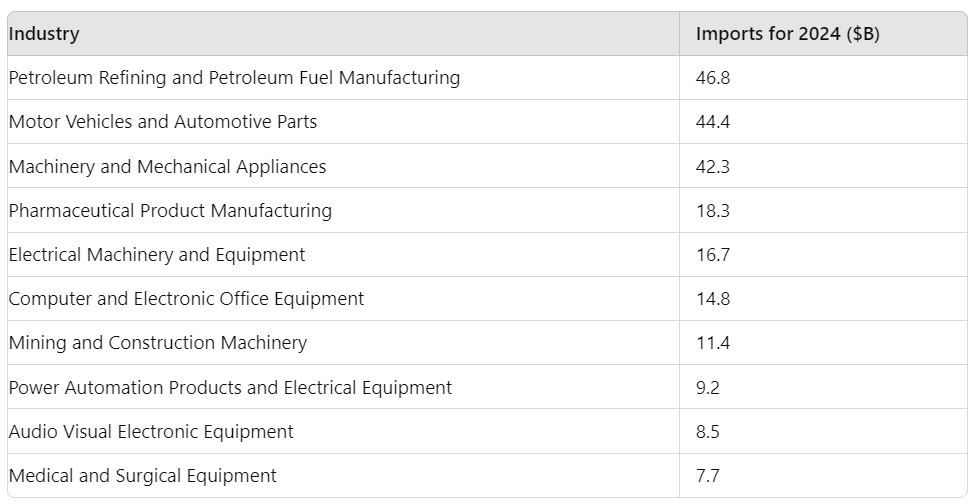
Australia’s imports play a vital role in the economy, ensuring that industries have access to the goods and materials they need for production and consumption. These imports not only support local businesses but also contribute to economic growth by facilitating trade relationships with other countries.
In 2024, Australia’s imports are projected to reach significant levels, reflecting steady growth compared to previous years. For instance, in 2023, the total import value was approximately $275.7 billion. Fluctuations in the Australian Dollar against other major currencies have also impacted import costs, making some international purchases more expensive.
Top 10 Products Imported to Australia in 2024
Australia’s diverse import needs in 2024 include significant expenditures on petroleum products, motor vehicles, and machinery, reflecting critical dependencies in energy, transportation, and industrial sectors. High imports of pharmaceuticals highlight the importance of healthcare, while substantial imports of electrical machinery and computer equipment emphasize technological and industrial demands. Investments in power automation and audio visual electronic equipment cater to renewable energy and consumer technology needs, respectively. Medical and surgical equipment imports ensure access to advanced healthcare technologies, showcasing Australia’s reliance on global trade to meet its varied economic and consumer requirements.
1. Petroleum Refining and Petroleum Fuel Manufacturing
Australia imports a substantial amount of refined petroleum products, valued at approximately $46.8 billion. This sector is essential for powering the country’s industrial, transportation, and residential energy needs. The primary suppliers are Singapore, South Korea, and Japan, which provide high-quality refined petroleum products.
2. Motor Vehicles and Automotive Parts
Motor vehicles and automotive parts are critical imports for Australia, totaling around $44.4 billion. These imports support both personal and commercial transportation needs. Major suppliers include Japan, Thailand, and Germany, reflecting Australia’s reliance on international automotive manufacturing.
3. Machinery and Mechanical Appliances
Machinery and mechanical appliances constitute a significant portion of Australia’s imports, valued at $42.3 billion. These imports are vital for various industries, including manufacturing and construction. Key suppliers are China, the United States, and Germany, offering advanced machinery to support industrial operations.
4. Pharmaceutical Product Manufacturing
Pharmaceutical products are crucial imports for Australia’s healthcare sector, amounting to $18.3 billion. These imports ensure access to essential medicines and medical supplies. The main sources are the United States, Germany, and Switzerland, known for their high-quality pharmaceutical products.
5. Electrical Machinery and Equipment
Electrical machinery and equipment imports are valued at $16.7 billion, supporting Australia’s technological infrastructure. These imports are vital for sectors such as telecommunications and consumer electronics. Primary suppliers include China, Japan, and the United States.
6. Computer and Electronic Office Equipment
Australia imports computer and electronic office equipment worth $14.8 billion. These imports are essential for business operations, educational institutions, and personal use. The leading suppliers are China, Japan, and the United States, providing cutting-edge technology.
7. Mining and Construction Machinery
Mining and construction machinery imports total $11.4 billion. These imports are crucial for Australia’s mining and construction industries, facilitating large-scale projects and operations. Key suppliers include the United States, Japan, and Germany.
8. Power Automation Products and Electrical Equipment
Imports of power automation products and electrical equipment are valued at $9.2 billion. These products are essential for Australia’s energy sector, supporting the transition to renewable energy. The primary suppliers are China, Germany, and the United States.
9. Audio Visual Electronic Equipment
Audio visual electronic equipment imports amount to $8.5 billion. These imports are vital for Australia’s entertainment and media industries. Major suppliers include China, Japan, and the United States.
10. Medical and Surgical Equipment
Medical and surgical equipment imports are valued at $7.7 billion. These imports are critical for Australia’s healthcare system, ensuring access to advanced medical technologies. The main suppliers are the United States, Germany, and Japan.
 Conclusion
Conclusion
Understanding the top imports to Australia in 2024 provides valuable insights into market trends and opportunities. These imports support various industries, drive economic growth, and enhance the quality of life for Australians.
At Connecta, we specialize in helping businesses navigate the complexities of global trade.
Contact us today to learn how we can help streamline your import processes and ensure your business thrives in the global marketplace.







 Conclusion
Conclusion



